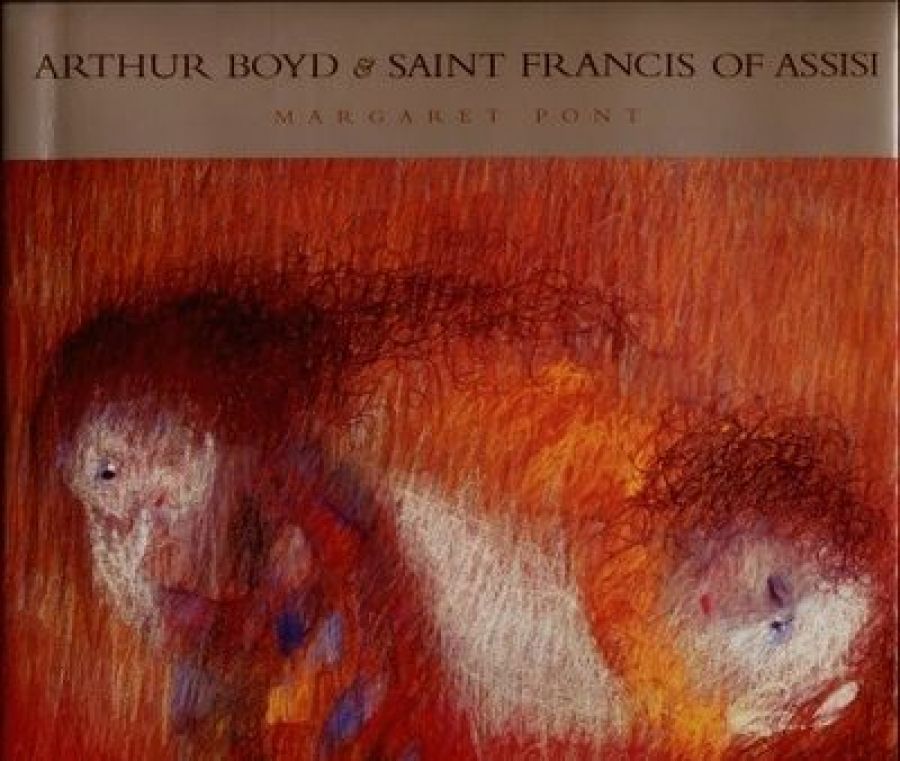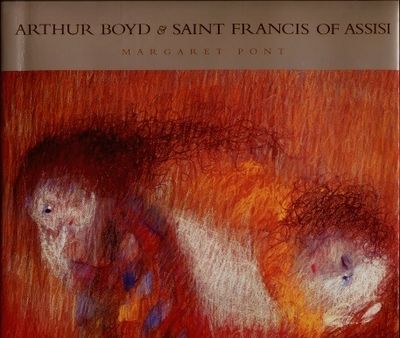
- Free Article: No
- Contents Category: Art
- Review Article: Yes
- Article Title: Saint Arthur
- Online Only: No
- Custom Highlight Text:
Arthur Boyd and Saint Francis of Assisi is based on Margaret Pont’s Master’s thesis, which she wrote at the University of Melbourne under the supervision of the medievalist Margaret Manion. During the 1960s, Arthur Boyd made more than twenty pastels depicting various events from the saint’s life. He followed this with a series of lithographs, all of which are listed in Pont’s detailed catalogue. Then, from 1972 to 1974, Boyd had twenty tapestries woven by the Manufactura Tapecarias de Portalegre in Portugal, to cartoons produced from transparencies of the original pastels. These works, which have never been exhibited together in their entirety, continue to gather dust in the Hume storage depot of the National Gallery of Australia. Pont also includes in her catalogue a number of related drawings, unfinished pastel sketches and three oil paintings dealing with the theme of St Francis.
- Book 1 Title: Arthur Boyd and Saint Francis of Assisi
- Book 1 Subtitle: Pastels, lithographs and tapestries, 1964–1974
- Book 1 Biblio: Macmillan Art Publishing, $88 hb, 144 pp, 1876832800
- Book 1 Cover Small (400 x 600):

- Book 1 Cover (800 x 1200):

The pastels, lithographs and tapestries are all reproduced in the book for the first time, which alone makes it a valuable contribution to the literature on Boyd and on modern Australian art in general, a literature that has dwindled in recent years. The text proper begins and ends with testimonials by religious figures and historians, including a preface by Vincenzo Coli, Custodian of the Sacro Convento, Basilica of San Francesco at Assisi; an introduction by Manion; and an epilogue by an American historian of religion, William Cook.
Pont’s contribution, which makes up the bulk of the book, is played very straight. The first chapter is given over to a short biography of Boyd. In solemn tones, Pont describes how in the ‘Brown Room’ of Boyd’s parents’ house at Murrumbeena, ‘readings of PhD theses took place’, before noting towards the end of the same paragraph that Boyd’s painting of the Brown Room ‘conveys a somewhat oppressive atmosphere, even a sense of captivity’, which doesn’t seem very surprising in the circumstances. Next, Pont moves on to a general account of ‘The Importance and Significance of Saint Francis and Assisi in Italy’ and of Francis’s representation in the visual arts (Giotto, Sassetta and Giovanni Bellini among others). Three chapters follow in which Pont discusses Boyd’s St Francis works by medium.
Boyd emerges from this account not only as a major modernist artist but also as a modern follower, almost an incarnation, of St Francis. His work is therefore prima facie religious. According to Pont:
Boyd, like St Francis, had an artistic vision which went hand in hand with his deeply personal experience of life. He believed in the redemptive possibilities of the creative spirit and also in nurturing these in a protected natural environment. Boyd’s gesture of donating the property of Bundanon and Riversdale, a last wilderness, to the Australian people and of building studios and classrooms to cultivate artistic enterprises is ultimately a Franciscan one. Bundanon offers a sacred wilderness in which to contemplate.
That may well be so. From another point of view, however, Pont’s comments might be taken as indicative of the mild case of identity crisis from which the book suffers: Arthur Boyd and Saint Francis of Assisi is not entirely sure whether it is history or hagiography. (Pont: ‘my thanks go to Arthur and Francis, figures who stand out like beacons in an often seemingly dark world’; ‘Arthur Boyd was born in 1920, into a family for which the idea of art was as essential to life as one’s daily bread’; ‘Arthur possessed an almost seer-like capacity’.)
The implicit assumption that Boyd’s interest in St Francis was motivated by religious conviction, if not identification, points towards an intriguing general problem in the historiography of modern art. In his latest book On the Strange Place of Religion in Contemporary Art (2004), James Elkins suggests that, for some people, ‘modern art like [Jackson] Pollock’s cannot be religious because that would undo the project of modernism by going against its own sense of itself’. Hardliners of this ilk would probably dismiss Boyd’s work as religious and therefore not modern (enough), while others might see it as modern and therefore not religious (enough). Elkins rightly claims that in contemporary discourse: ‘Talk about art and talk about religion have become alienated from one another.’
Of course, these are extreme positions, but the point remains that the place and status of religion in modern art is far from clear. On the evidence of Pont’s book, Boyd’s St Francis works are genuinely original reinterpretations of a familiar religious subject. That said, it is difficult to suppress the nagging suspicion that the specific character of these works’ religious and/or spiritual sentiment, if present in any sense other than as subject matter, is significantly more complex and nuanced than the book suggests.


Comments powered by CComment